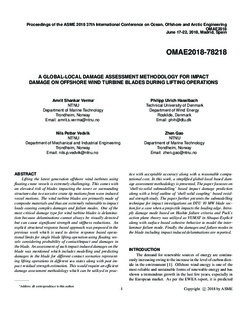| dc.contributor.author | Verma, Amrit Shankar | |
| dc.contributor.author | Haselbach, Philipp Ulrich | |
| dc.contributor.author | Vedvik, Nils Petter | |
| dc.contributor.author | Gao, Zhen | |
| dc.date.accessioned | 2019-02-21T14:47:41Z | |
| dc.date.available | 2019-02-21T14:47:41Z | |
| dc.date.created | 2018-11-02T15:40:58Z | |
| dc.date.issued | 2018 | |
| dc.identifier.isbn | 978-0-7918-5131-9 | |
| dc.identifier.uri | http://hdl.handle.net/11250/2586852 | |
| dc.description.abstract | Lifting the latest generation offshore wind turbines using floating crane vessels is extremely challenging. This comes with an elevated risk of blades impacting the tower or surrounding structures due to excessive crane tip motions from wave induced vessel motions. The wind turbine blades are primarily made of composite materials and thus are extremely vulnerable to impact loads causing complex damages and failure modes. One of the most critical damage type for wind turbine blades is delamination because delaminations cannot always be visually detected but can cause significant strength and stiffness reductions. An explicit structural response based approach was proposed in the previous work which is used to derive response based operational limits for single blade lifting operation using floating vessels considering probability of contact/impact and damages in the blade. An assessment of such impact induced damages on the blade was mentioned which includes modelling and predicting damages in the blade for different contact scenarios representing lifting operations in different sea states along with post impact residual strength estimation. This would require an efficient damage assessment methodology which can be utilized in practice with acceptable accuracy along with a reasonable computational cost. In this work, a simplified global-local based damage assessment methodology is presented. The paper focusses on ’shell-to-solid submodelling’ based impact damage prediction along with a brief outline of ’shell-solid coupling’ based residual strength study. The paper further presents the submodelling technique for impact investigations on DTU 10 MW blade section for a case when a projectile impacts the leading edge. Intraply damage mode based on Hashin failure criteria and Puck’s action plane theory was utilized as VUMAT in Abaqus-Explicit along with surface based cohesive behavior to model the inter-laminar failure mode. Finally, the damages and failure modes in the blade including impact induced delaminations are reported. | nb_NO |
| dc.language.iso | eng | nb_NO |
| dc.publisher | ASME | nb_NO |
| dc.relation.ispartof | ASME 2018 37th International Conference on Ocean, Offshore and Arctic Engineering - Volume 10: Ocean Renewable Energy | |
| dc.title | A Global-local Damage Assessment Methodology for Impact Damage on Offshore Wind Turbine Blades during Lifting Operations | nb_NO |
| dc.type | Chapter | nb_NO |
| dc.description.version | publishedVersion | nb_NO |
| dc.identifier.doi | 10.1115/OMAE2018-78218 | |
| dc.identifier.cristin | 1626497 | |
| dc.relation.project | Norges forskningsråd: 237929 | nb_NO |
| dc.description.localcode | Copyright © 2018 by ASME | nb_NO |
| cristin.unitcode | 194,64,20,0 | |
| cristin.unitcode | 194,64,92,0 | |
| cristin.unitname | Institutt for marin teknikk | |
| cristin.unitname | Institutt for maskinteknikk og produksjon | |
| cristin.ispublished | true | |
| cristin.fulltext | postprint | |
| cristin.qualitycode | 1 | |
